Building Space Heating with a Solar-Assisted Heat Pump Using Roof-Integrated Solar Collectors
Abstract
:1. Introduction
2. Design Process of the Proposed System
2.1. Building Description
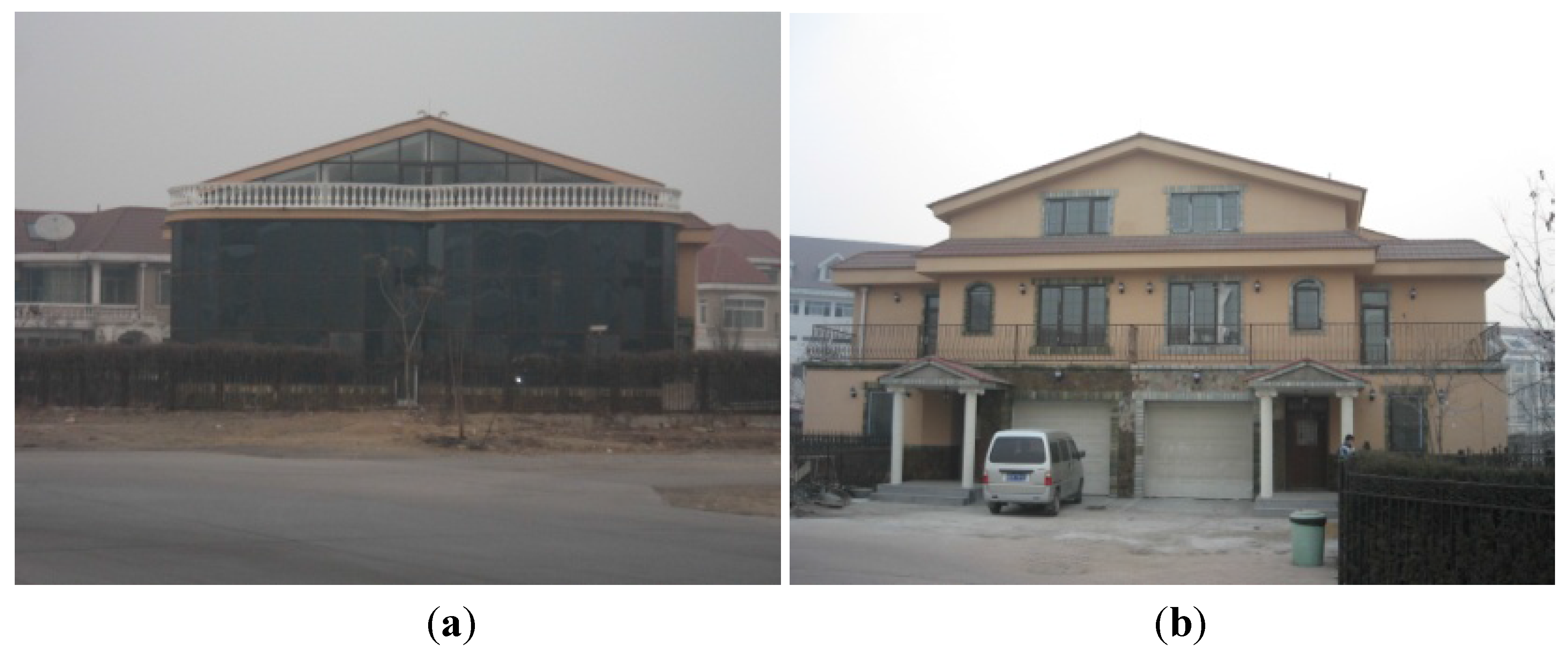
2.2. Space Heating Load Calculation
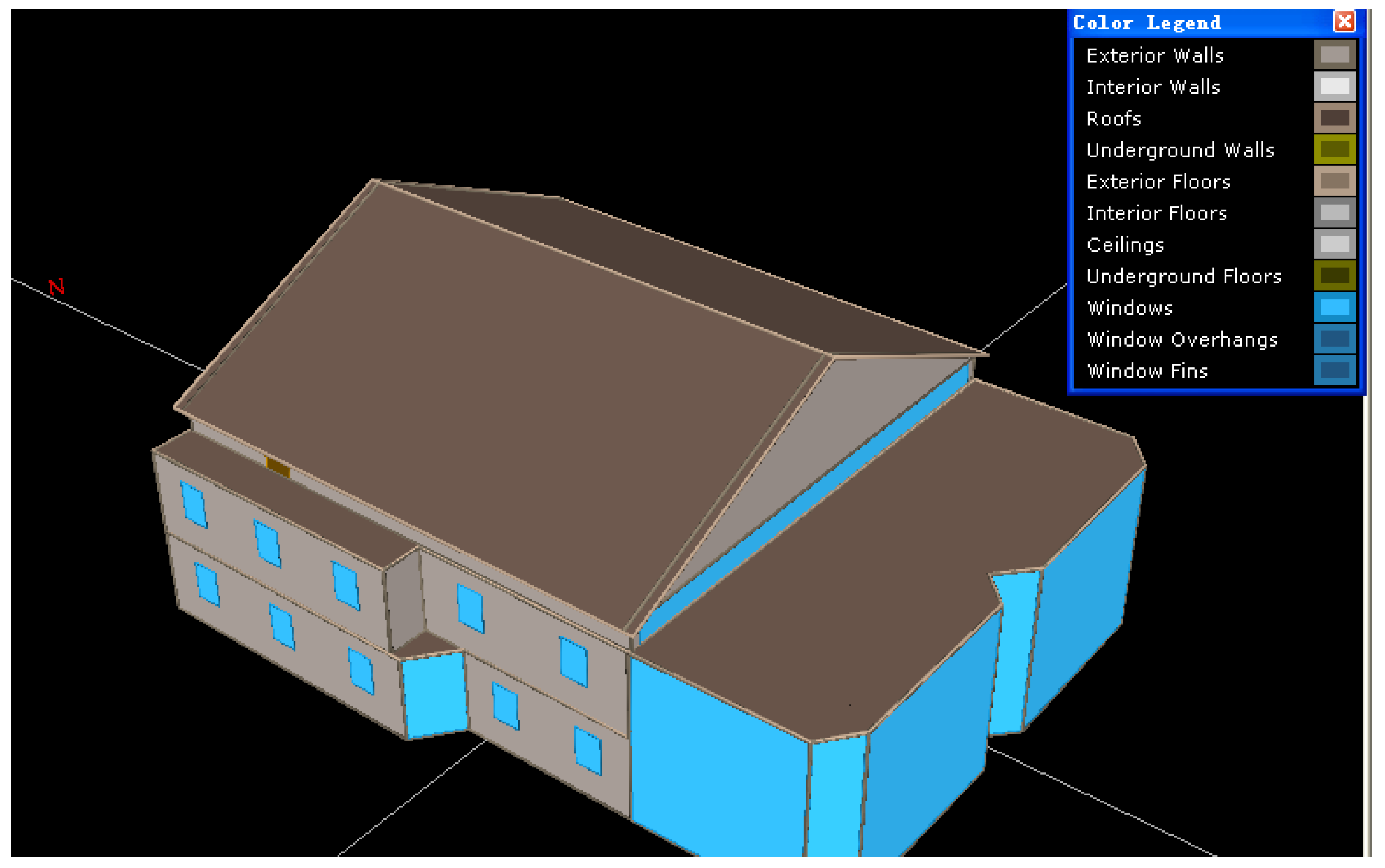
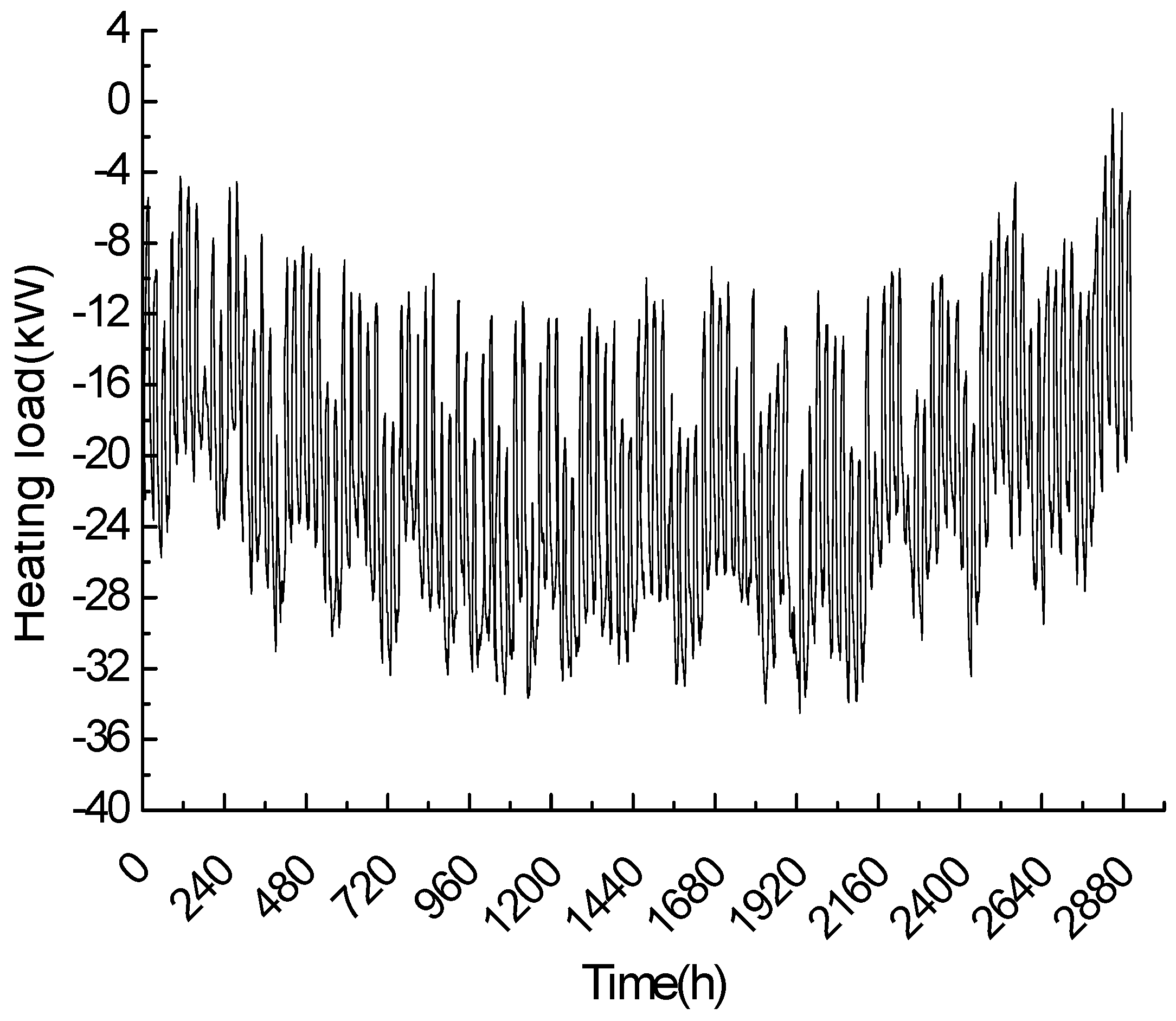
2.3. Solar Roofing
2.3.1. Integration Structure
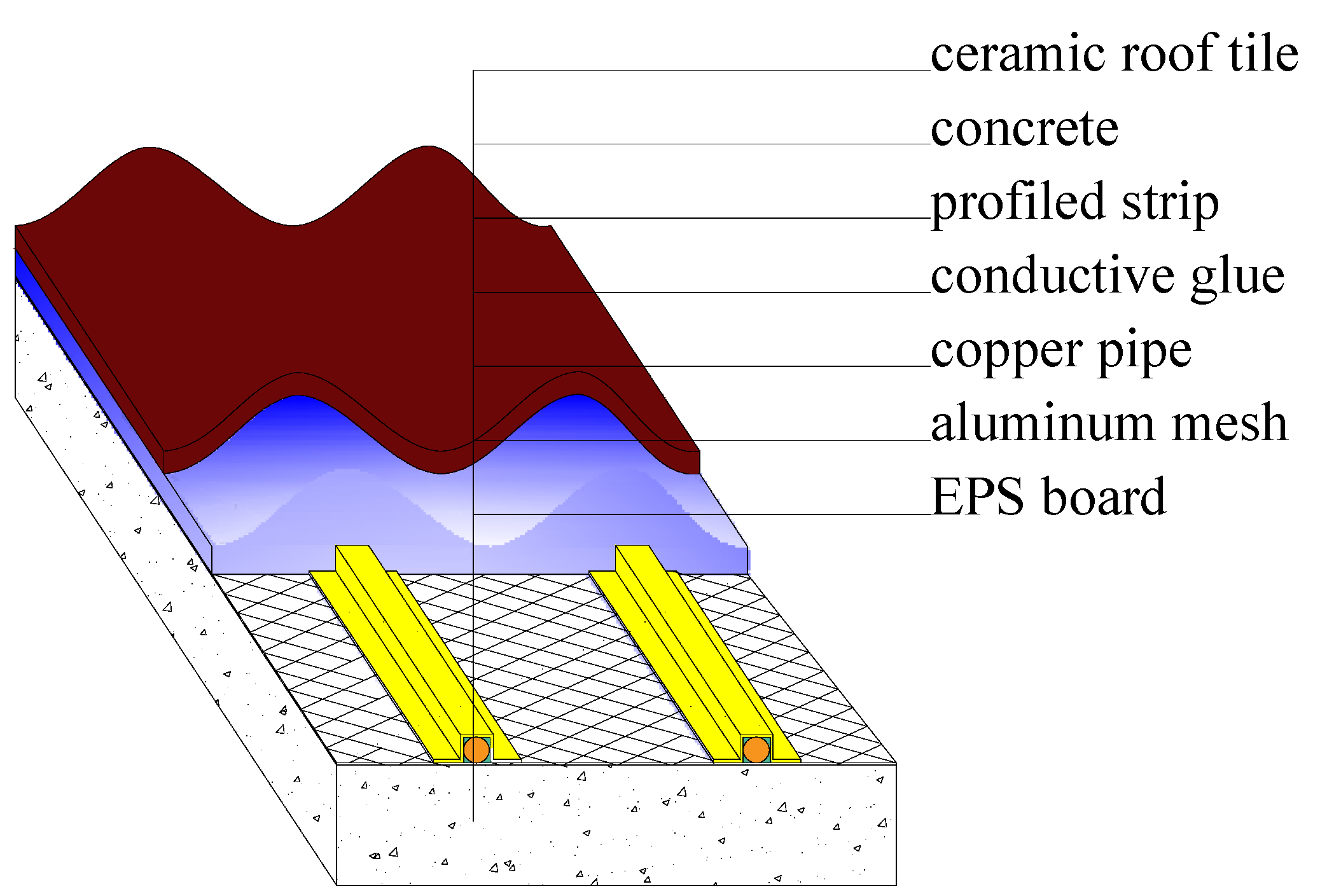
| Item | Feature Size (mm) | λ (W/m K) | ρ (kg/m3) | Cp (J/kg K) |
|---|---|---|---|---|
| Copper tube | 8 × 0.5 | 398 | 8954 | 406 |
| Aluminum mesh plate | 3600 × 1800 | 227.8 | 2770 | 921 |
| Profiled strip | 227.8 | 2770 | 921 | |
| Ceramic tile | 360 × 270 × 10 | 0.72 | 2300 | 879 |
| Conductive glue | 7 | 1755 | 545 | |
| EPS | 2000 × 1000 × 80 | 0.035 | 30 | |
| Concrete paving | 0.93 | 2400 | 920 |
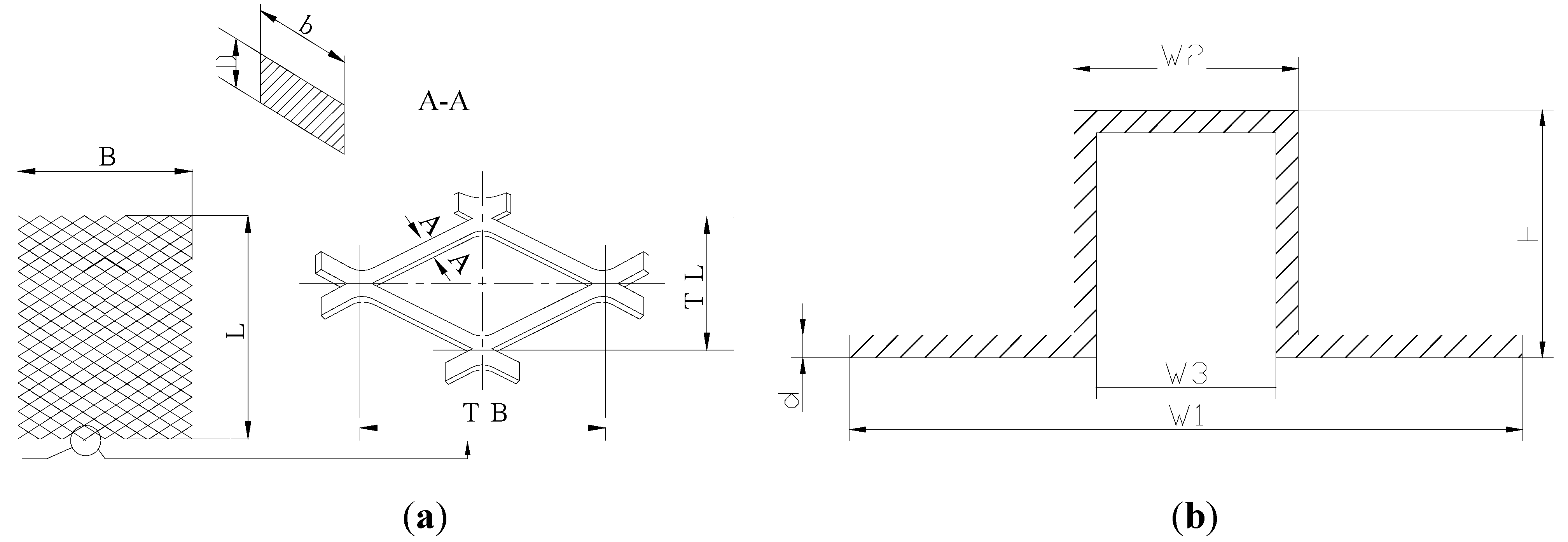
2.3.2. Thermal Performance Evaluation
2.3.2.1. Model Description

2.3.2.2. Simulation Results and Analysis

2.4. The Coupled Heat Pump
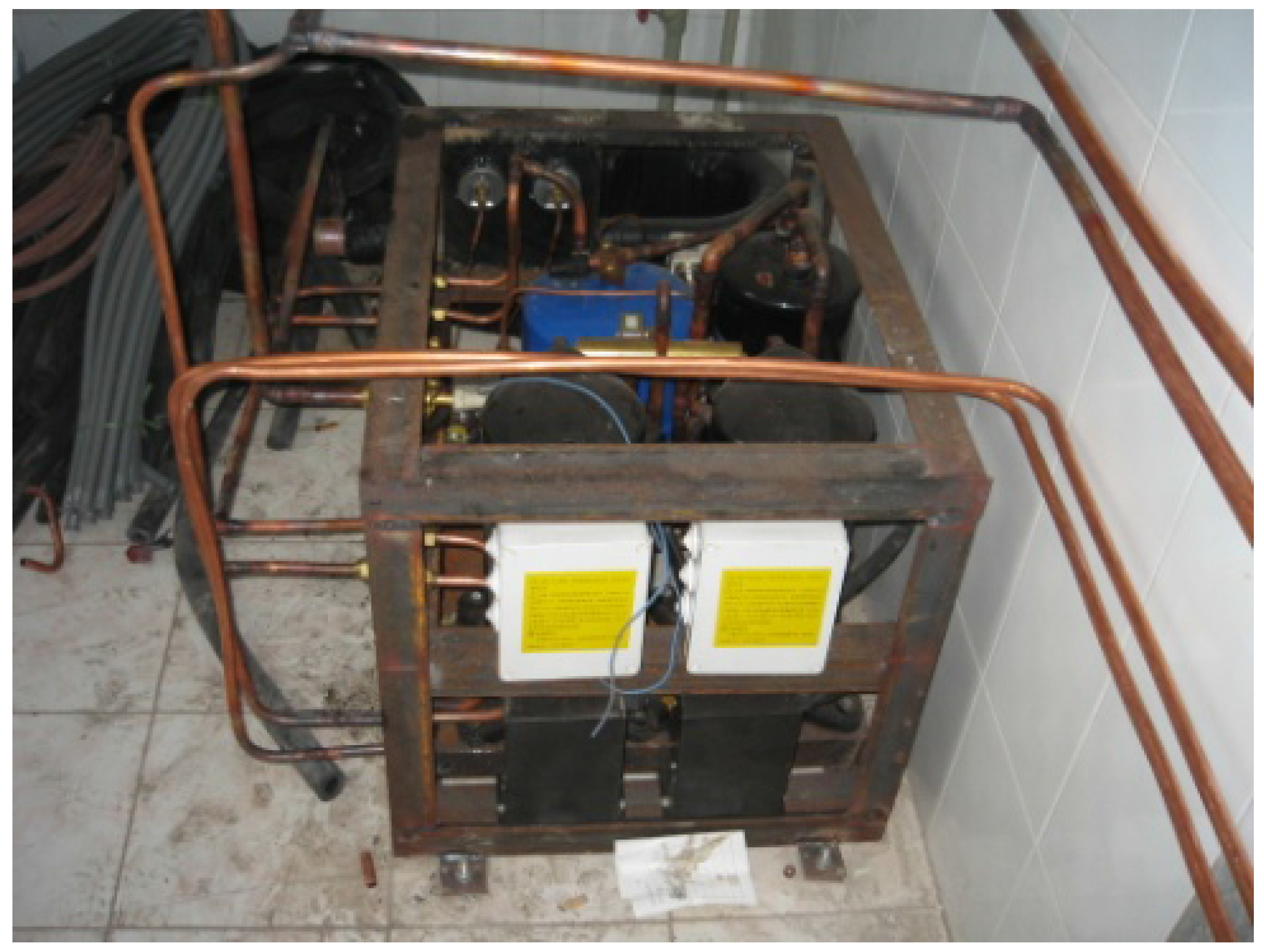
| Name | Amount | Technical Parameter |
|---|---|---|
| Scroll Compressor | 4 | rated cooling capacity of 8.8 kW |
| Expansion Valve | 2 | rated cooling capacity of 19.1 kW |
| Condenser | 1 | heat interchanging area of 6 m2 |
| Evaporator | 1 | heat interchanging area of 5 m2 |
| Pump | 2 | pumping head of 25 m, flow discharge of 6 m3/h |
2.5. The Radiant Floor Heating System
3. Real-Detected Performance of the Solar-Assisted Heat Pump

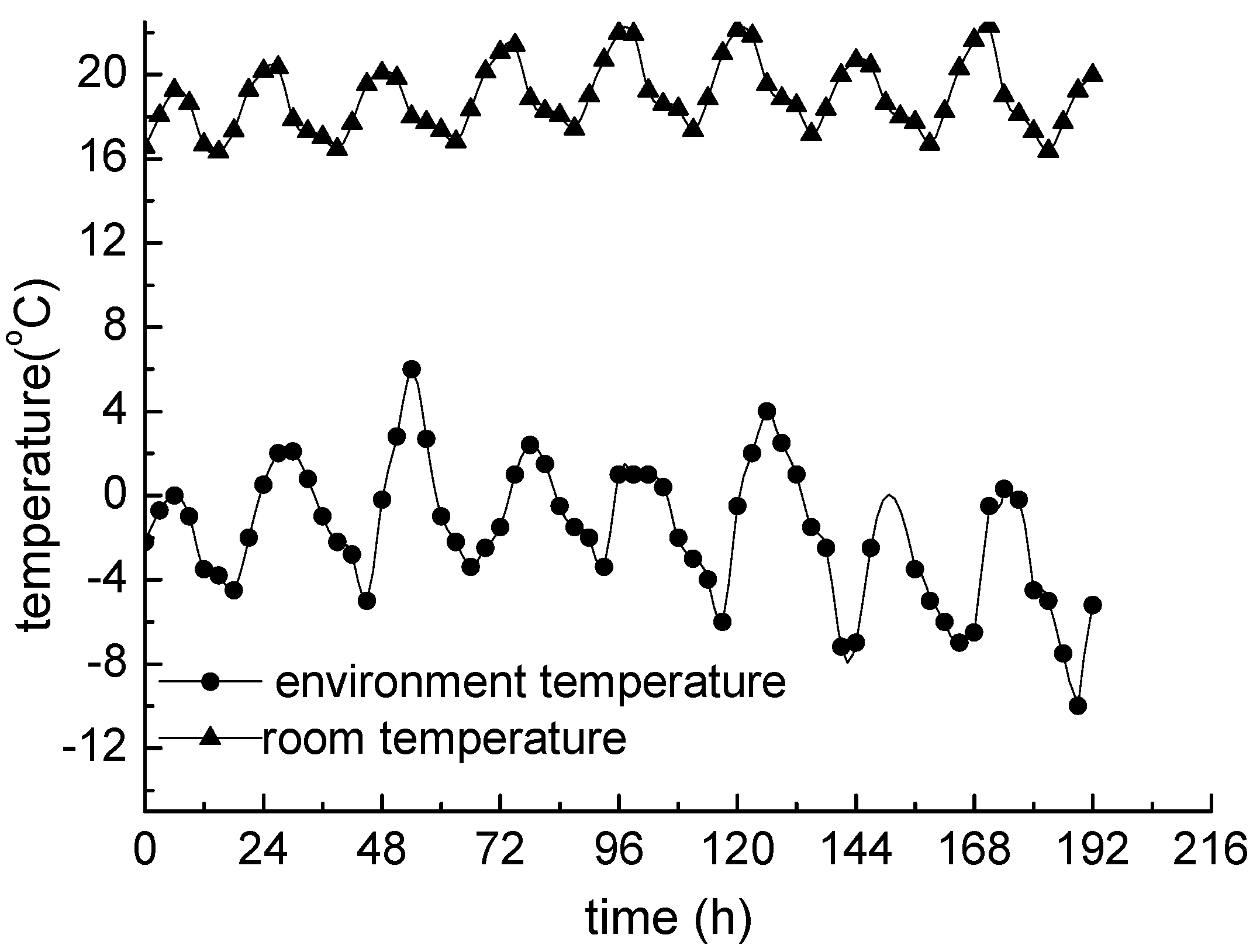
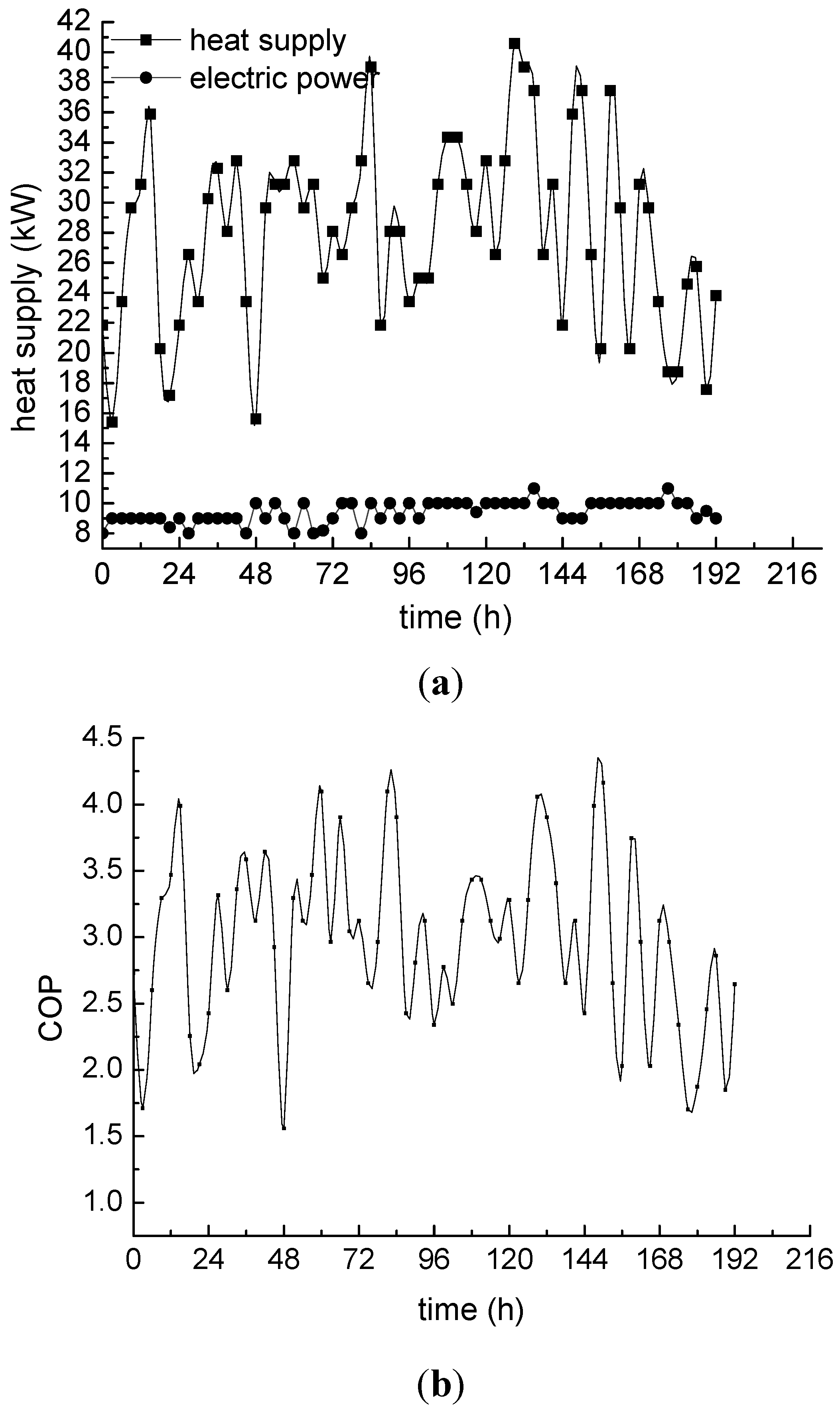
4. Conclusions
Nomenclature:
| Cp | specific heat of fluid at constant pressure (J kg−1 K−1); |
| ha | ambient heat loss coefficient (W m−2 K−1); |
| hc | convection heat loss coefficient (W m−2 K−1); |
| hf | fluid heat transfer coefficient (W m−2 K−1); |
| hr | radiation heat loss coefficient (W m−2 K−1); |
| I | solar insolation (W m−2); |
| K | thermal conductivity (W m−1K−1); |
| kt | thermal conductivity of tile(W m−1K−1); |
| Pr | Prandtl number; |
| q | heat flux (W m−2); |
| Re | Renolds number; |
| T | temperature (K); |
| Tf | fluid temperature (K); |
| Ta | ambient temperature (K); |
| Tdp | dew point temperature (K); |
| Tsky | temperature of sky (K); |
| T | time (s); |
| V | velocity (m s−1); |
| ρ | density (kg m−3); |
| ε | average emittance; |
| εsky | emittance of the sky; |
| εt | emittance of the tile; |
| λ | coefficient of thermal conductivity (W m−1 K−1) |
References
- Zhai, X.Q.; Wang, R.Z. Experiences on solar heating and cooling in China. Renew. Sustain. Energy Rev. 2008, 12, 1110–1128. [Google Scholar] [CrossRef]
- Hartkopf, V.; Loftness, S.; Duckworth, S.; Lee, P.; Drake, J.; Rainer, G. The Intelligent Workplace Retrofit Initiative: DOE Building Studies; The U.S. Department of Energy: Washington, DC, USA, 1994. [Google Scholar]
- Bopshetty, S.V.; Nayak, J.K.; Sukhatme, S.P. Performance analysis of a solar concrete collector. Energy Convers. Manag. 1992, 33, 1007–1016. [Google Scholar] [CrossRef]
- Chaurasia, P.B.L. Solar water heaters based on concrete collectors. Energy 2000, 25, 703–716. [Google Scholar] [CrossRef]
- Bilgen, E.; Richard, M.A. Horizontal concrete slabs as passive solar collectors. Sol. Energy 2002, 72, 405–413. [Google Scholar] [CrossRef]
- Medved, S.; Arkar, C.; Cerne, B. A large-panel unglazed roof-integrated liquid solar collector––Energy and economic evaluation. Sol. Energy 2003, 75, 455–467. [Google Scholar] [CrossRef]
- Abbott, A.B. Analysis of Thermal Energy Collection from Precast Concrete Roof Assemblies. Master’s Thesis, Virginia Polytechnic Institute and State University, Blacksburg, VA, USA, 2004. [Google Scholar]
- Kara, O.; Ulgen, K.; Hepbasli, A. Exergetic assessment of direct-expansion solar-assisted heat pump systems Review and modeling. Renew. Sustain. Energy Rev. 2008, 12, 1383–1401. [Google Scholar] [CrossRef]
- MacArthur, J.W.; Palm, W.J.; Lessmann, R.C. Performance analysis and cost optimization of a solar-assisted heat pump system. Sol. Energy 1978, 21, 1–9. [Google Scholar] [CrossRef]
- Freeman, T.L.; Mitchell, J.W.; Audit, T.E. Performance of combined solar–heat pump systems. Sol. Energy 1979, 22, 125–135. [Google Scholar] [CrossRef]
- Pedersen, P.V. System design optimization for large building integrated solar heating systems for domestic hot water. Sol. Energy 1993, 50, 267–273. [Google Scholar] [CrossRef]
- Kaygsuz, K.; Ayhan, T. Exergy analysis of solar-assisted heat-pump systems for domestic heating. Energy Int. J. 1993, 18, 1077–1085. [Google Scholar] [CrossRef]
- Smith, R.R.; Hwang, C.C.; Dougall, R.S. Modeling of a solar-assisted dessicant air conditioner for residential building. Energy Int. J. 1994, 19, 679–691. [Google Scholar] [CrossRef]
- Abou-Ziyan, H.Z.; Ahmed, M.F.; Metwally, M.N.; EI-Hameed, A. Solar-assisted R22 and R134a heat pump systems for low-temperature applications. Appl. Therm. Eng. 1997, 17, 455–469. [Google Scholar] [CrossRef]
- Badescu, V. Model for a solar-assisted climatization system. Energy Int. J. 1998, 23, 753–766. [Google Scholar] [CrossRef]
- Torres, R.; Picon, N.M.; de Cervantes, G.J. Exergy analysis and optimization of a solar-assisted heat pump. Energy Int. J. 1998, 23, 337–344. [Google Scholar] [CrossRef]
- Huang, H.; Xinshi, G.; Yuehong, S. Theoretical thermal performance analysis of two solar-assisted heat-pump systems. Int. J. Energy Res. 1999, 23, 1–6. [Google Scholar] [CrossRef]
- Ito, S.; Miura, N.; Wang, K. Performance of a heat pump using direct expansion solar collectors. Sol. Energy 1999, 65, 189–196. [Google Scholar] [CrossRef]
- Esen, M. Thermal performance of a solar-aided latent heat store used for space heating by heat pump. Sol. Energy 2000, 69, 15–25. [Google Scholar] [CrossRef]
- Badescu, V. Model of a solar-assisted heat pump system for space heating integrating a thermal energy storage unit. Energy Build. 2002, 34, 715–726. [Google Scholar] [CrossRef]
- Badescu, V. Model of a space heating system integrating a heat pump, photothermal collectors and solar cells. Renew. Energy 2002, 27, 489–505. [Google Scholar] [CrossRef]
- Badescu, V. First and second law analysis of a solar assisted heat pump based heating system. Energy Convers. Manag. 2002, 43, 2539–2552. [Google Scholar] [CrossRef]
- Lu, A.; Charters, W.W.S.; Chaichana, C. Solar heat pump systems for domestic hot water. Sol. Energy 2002, 73, 169–175. [Google Scholar] [CrossRef]
- Badescu, V. Model of a thermal energy storage device integrated into a solar assisted heat pump system for space heating. Energy Convers. Manag. 2003, 44, 1589–1604. [Google Scholar] [CrossRef]
- Hawlader, M.N.A.; Chou, S.K.; Jahangeer, K.A.; Rahman, S.M.A.; Eugene, L.K.W. Solar assisted heat-pump dryer and water heater. Appl. Energy 2003, 74, 185–193. [Google Scholar] [CrossRef]
- Sattari, S.; Farhanieh, B. A parametric study on radiant floor heating system performance. Renew. Energy 2006, 31, 1617–1626. [Google Scholar] [CrossRef]
- Cho, S.H.; Zaheer-uddin, M. An experimental study of multiple parameter switching control for radiant floor heating systems. Energy 1999, 24, 433–444. [Google Scholar] [CrossRef]
- China Meteorological BureauClimate Information CenterClimate Data OfficeTsinghua UniversityDepartment of Building Science and TechnologyChina Standard Weather Data for Analyzing Building Thermal Conditions; China Building Industry Publishing House: Beijing, China, 2005; in Chinese.
- James, J. eQUEST Introductory Tutorial; Hirsch & Associates: Anaheim, CA, USA, 2004; pp. 3–4. [Google Scholar]
- Medrano, M.; Brouwer, J.; McDonell, V.; Mauzey, J.; Samuelsen, S. Integration of distributed generation systems into generic types of commercial buildings in California. Energy Build. 2008, 40, 537–548. [Google Scholar] [CrossRef]
- Bejan, A.; Kraus, A.D. Heat Transfer Handbook; John Wiley & Sons, Inc.: Hoboken, NJ, USA, 2002; pp. 829–831. [Google Scholar]
- Duffie, J.A.; Beckman, W.A. Solar Engineering of Thermal Processes; John Wiley and Sons, Inc.: Hoboken, NJ, USA, 1991; pp. 164–165. [Google Scholar]
- Duffie, J.A.; Beckman, W.A. Solar Engineering of Thermal Processes; John Wiley and Sons, Inc.: Hoboken, NJ, USA, 1991; pp. 148–149. [Google Scholar]
- Clark, E.; Berdahl, P. Radiative Cooling: Resource and Applications; Proceedings of the Passive-Cooling Workshop: Amherst, MA, USA, 1980; pp. 177–212. [Google Scholar]
© 2011 by the authors; licensee MDPI, Basel, Switzerland. This article is an open access article distributed under the terms and conditions of the Creative Commons Attribution license (http://creativecommons.org/licenses/by/3.0/).
Share and Cite
Yang, Z.; Wang, Y.; Zhu, L. Building Space Heating with a Solar-Assisted Heat Pump Using Roof-Integrated Solar Collectors. Energies 2011, 4, 504-516. https://doi.org/10.3390/en4030504
Yang Z, Wang Y, Zhu L. Building Space Heating with a Solar-Assisted Heat Pump Using Roof-Integrated Solar Collectors. Energies. 2011; 4(3):504-516. https://doi.org/10.3390/en4030504
Chicago/Turabian StyleYang, Zhiyong, Yiping Wang, and Li Zhu. 2011. "Building Space Heating with a Solar-Assisted Heat Pump Using Roof-Integrated Solar Collectors" Energies 4, no. 3: 504-516. https://doi.org/10.3390/en4030504




